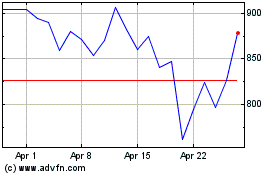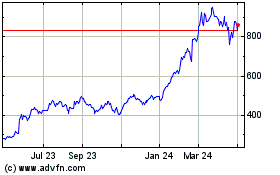Why Fewer Chips Say 'Made in the U.S.A.'
04 November 2020 - 1:26AM
Dow Jones News
By Asa Fitch and Luis Santiago
In 1990, the U.S. and Europe produced more than three-quarters
of the world's semiconductors. Now, they produce less than a
quarter. Japan, South Korea, Taiwan and China have risen to squeeze
out the U.S. and Europe. And China is on pace to become the world's
largest chip producer by 2030.
The epicenter of chip production shifted partly because
governments outside the U.S. offered often hefty financial
incentives for factory construction to build up domestic
industries. Chip companies also have been attracted by growing
networks of suppliers outside of the U.S., and an expanding
workforce of skilled engineers capable of operating expensive
manufacturing machinery.
While manufacturing has left the U.S. in recent decades, many of
the world's largest chip companies are still U.S.-based. Intel
Corp., the largest American chip company by sales, does much of its
manufacturing in the U.S., although it too has opened factories in
places like Ireland, Israel and China. Other big U.S. chip
companies, though, contract out all their manufacturing to Asian
producers such as Taiwan Semiconductor Manufacturing Co. Nvidia
Corp., for example, which is based in Santa Clara, Calif., and is
America's biggest semiconductor company by market value, has its
chips made largely outside the U.S. As of 2019, the share of
semiconductor sales by U.S.-based companies was around 47%.
The growth of contract manufacturers like TSMC, the largest and
most advanced of its kind, have helped speed the shift of
chip-making outside the U.S. South Korea's Samsung Electronics Co.
is another big player in the contract chip-making business, and
most of its factories aren't in the U.S. The raw materials that go
into chip-making, including industrial chemicals and silicon
crystals, also largely come from outside the U.S.
The U.S. has kept a larger slice of the industrial pie in some
other fields of chip-making -- especially in ubiquitous software
tools used to design the layout of chip circuitry.
The flight of high-tech manufacturing from the U.S. has been a
theme for decades as supply chains and factories in Asia developed,
taking advantage not just of government handouts but cheaper labor
and less regulation. That exodus is particularly pronounced in
computing hardware and consumer electronics, compared with other
high-profile manufacturing sectors.
If things continue on their current trajectory, the U.S.'s share
of chip-making is expected to shrink further in coming years, in
part because China's capacity is increasing quickly.
This trend has caused concern in Washington as the U.S.'s
technological rivalry with Beijing heats up. China is pouring tens
of billions of dollars into its chip industry, hoping to eventually
match or surpass other countries.
Chips are increasingly being viewed across the globe as a
national-security priority because of the powerful role they play
not only in consumer technology but in militaries and cyberwarfare.
The U.S. has placed new restrictions on China's industry in recent
years, including blacklisting Chinese telecom giant Huawei
Technologies Co. and preventing some Chinese chip-makers from
buying American manufacturing equipment without a license.
The coronavirus pandemic has given further impetus to a U.S.
push to bring more of the chip-making industry back to American
soil. Factory shutdowns because of the health crisis disrupted
supply chains in Asia, fueling concern that the industry's
concentration there could impact U.S. access to a critical
technology during times of crisis.
Analysts say U.S. government incentives could help to reverse
that trend. A top chip-making factory -- the kind that makes
central processing units that go into computers -- can easily cost
more than $30 billion to build and operate for 10 years, analysts
estimate. So financial assistance to defray some of those costs can
change the calculus on whether to invest or not.
The U.S. historically hasn't offered federal incentives to
chip-making, although states do provide a variety of enticements
for factory-building, including subsidized land and tax breaks. In
Asia, by contrast, countries typically offer free or cheap land,
and give more help with purchasing manufacturing equipment that
accounts for most of the cost of chip-making.
Write to Asa Fitch at asa.fitch@wsj.com and Luis Santiago at
luis.santiago@wsj.com
(END) Dow Jones Newswires
November 03, 2020 09:11 ET (14:11 GMT)
Copyright (c) 2020 Dow Jones & Company, Inc.
NVIDIA (NASDAQ:NVDA)
Historical Stock Chart
From Mar 2024 to Apr 2024

NVIDIA (NASDAQ:NVDA)
Historical Stock Chart
From Apr 2023 to Apr 2024
